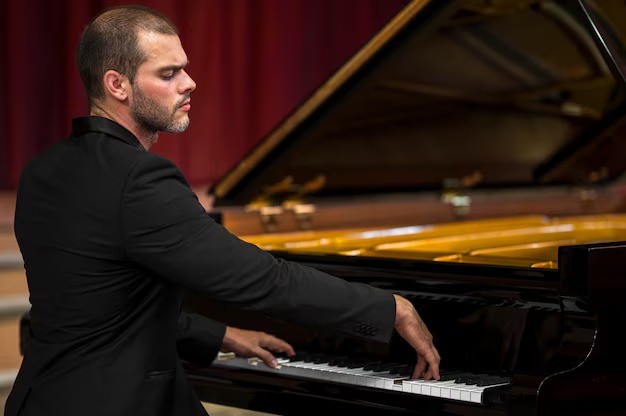
23 December 2024
Exploring Dystopian Operas A Beginner Guide to the Red Rising

Throughout history, the realm of theatrical music has been enriched by the extraordinary talents of individuals who have dedicated their lives to crafting emotional narratives through sound. These artists have transcended cultural boundaries, captivating audiences with their unique ability to weave intricate tales filled with passion, love, and tragedy. Their works continue to resonate, eliciting powerful reactions and inspiring new generations of musicians and performers.
Each creator has carved out a distinct identity, leaving an indelible mark on the landscape of this artistic form. From lush orchestral textures to haunting arias, the aural experiences they offer vary widely yet share a common thread–an unwavering commitment to storytelling. The personal struggles and triumphs of these talents reflect the times in which they lived, providing insight into the social and emotional fabric of their eras.
Exploring the legacies of these iconic artisans and their noteworthy contributions reveals not just the evolution of musical expression, but also the timeless themes that unite humanity. Their works invite us to share in the journey of the characters they portray, making the emotional experience both universal and deeply personal. As we delve into the lives and achievements of these remarkable figures, we uncover a treasure trove of inspiration that continues to ignite our imaginations.
Unraveling the story of a remarkable individual who left an indelible mark on the world of music reveals a journey filled with creativity, passion, and extraordinary talent. His contributions continue to resonate with audiences, inspiring generations to appreciate the beauty of melodic expression.
Wolfgang Amadeus Mozart, born in 1756 in Salzburg, Austria, exhibited prodigious abilities from an exceptionally young age. His father, Leopold, a composer and musician himself, recognized the gifts of his son early on and devoted significant effort to nurturing his talents. This dedication led to numerous performances across Europe, where the young maestro dazzled royal courts and captivated listeners.
As he matured, Mozart’s compositions evolved, embracing various styles and influences. His ability to blend different musical elements while maintaining a distinctive voice became apparent in works such as The Marriage of Figaro, Don Giovanni, and The Magic Flute. Each creation showcased his genius in character development and emotional depth, setting a new standard for narrative and drama in the musical landscape.
Despite his acclaim, Mozart’s life was not without challenges. He faced financial difficulties and struggles with patronage, which ultimately impacted his output. Nevertheless, his relentless pursuit of artistic excellence and innovation allowed him to create an impressive body of work that remains celebrated around the globe.
The legacy of this extraordinary talent continues to inspire musicians and enthusiasts alike, ensuring that his contributions to the cultural and artistic heritage endure for future generations.
Giuseppe Verdi stands as a pivotal figure in the evolution of theatrical music in Italy, shaping its narrative and emotional landscapes. His innovative approach not only elevated the art form but also left an indelible mark on the characters and storytelling techniques employed by his contemporaries and successors.
Verdi’s mastery in weaving intricate melodies with profound themes allowed audiences to connect deeply with the characters. This ability to evoke strong emotions through music revolutionized the emotional depth found in theatrical works, establishing new benchmarks for expression and human experience.
His compositions frequently explored themes of love, power, and redemption, mirroring the societal changes occurring in Italy during his lifetime. This interplay between music and societal context facilitated the creation of works that were not merely performances, but resonant reflections of contemporary issues.
| Key Works | Impact on the Genre |
|---|---|
| La Traviata | Expanded characterization and emotional complexity |
| Aida | Introduced grand themes and diverse cultural influences |
| Rigoletto | Highlighted moral ambiguities and human flaws |
| Otello | Innovative use of ensemble and orchestration |
Ultimately, Verdi’s contributions established a foundation upon which future generations could build, ensuring that the art form remained relevant and resonant within the cultural fabric of Italy and beyond. His legacy endures, inspiring countless artists to explore the depths of human emotion through the power of music.
The remarkable transformation brought forth by the renowned German maestro marked a significant departure from traditional narratives and practices. His innovative concepts reshaped the very essence of theatrical storytelling through the integration of music, drama, and visual art, establishing a new paradigm within the realm of performance arts.
The visionary approach of this composer emphasized the unity of various elements, striving for a seamless blend that would elevate the audience’s experience. His emphasis on a continuous musical fabric, rather than distinct numbers or sections, created an immersive atmosphere that captivated spectators.
| Work | Year | Notable Features |
|---|---|---|
| The Ring Cycle | 1869-1876 | Epic narrative, leitmotifs, integration of mythologies |
| Tristan und Isolde | 1865 | Harmonic innovation, exploration of love and longing |
| Parsifal | 1882 | Spiritual themes, ritualistic elements, blending of music and text |
His pioneering techniques not only influenced contemporaries but also left an indelible mark on the landscape of future dramatic works, ensuring that his legacy endures in the collective memory of the arts. The intricate architectural designs of his compositions continue to inspire countless creators across varied genres, affirming the timelessness of his revolutionary vision.
Giacomo Puccini is celebrated for his ability to evoke deep emotions and create captivating narratives through his notable creations. His detailed characterizations and rich orchestration have left a significant mark on the landscape of vocal music. The following highlights some of his most distinguished creations that continue to resonate with audiences around the world.
La Bohème
This poignant tale of love and loss among a group of young bohemians in Paris stands as one of Puccini’s most cherished works. Its lyrical melodies and relatable characters make it a perennial favorite.
Tosca
A gripping drama intertwined with themes of passion, politics, and sacrifice. The powerful arias and intense emotional depth contribute to its lasting impact in the realm of performing arts.
Madama Butterfly
This tragic story of love and betrayal highlights cultural contrasts and personal tragedy, accentuated by beautifully haunting music that enhances its dramatic core.
Turandot
Puccini’s final piece, known for its grand scale and unforgettable arias, delves into themes of love, power, and the human condition, wrapped in an exotic setting that captivates the audience.
Each of these works illustrates Puccini’s prowess in blending rich storytelling with innovative musical elements, ensuring his legacy endures through generations.
Claude Debussy emerged as a pivotal figure within the realm of music, closely associated with a transformative artistic era that sought to break away from traditional norms. This innovative movement was characterized by an emphasis on atmosphere, texture, and nuance, paralleling developments in visual arts and literature during the late 19th and early 20th centuries.
Numerous factors shaped Debussy’s style and approach to composition:
Debussy’s creations broke new ground with their distinctive sound and innovative structure:
Overall, Debussy’s contributions not only marked a significant departure from conventional musical forms but also set the stage for future generations of musicians seeking new modes of expression.
The contemporary landscape of music has been significantly shaped by innovative figures who have redefined the boundaries of theatrical vocal performance. These individuals bring fresh perspectives, blending traditional elements with modern sensibilities to create works that resonate with today’s audiences.
Contemporary creators have introduced a variety of styles and themes, including:
Noteworthy contributions include:
These advancements not only enrich the genre but also attract a diverse audience, ensuring the lasting relevance of theatrical vocal arts in the cultural sphere.
Richard Wagner is considered one of the most influential composers in the history of operatic music. His innovative use of harmony, orchestration, and the concept of the Gesamtkunstwerk, or total artwork, revolutionized opera and laid the groundwork for future composers.
Benjamin Britten was a pivotal figure in 20th-century operatic music, known for his ability to blend traditional and modern elements. His operas, such as “The Turn of the Screw,” showcase his unique approach to storytelling and character development, making him a significant composer of his time.
Claudio Monteverdi is often regarded as the father of modern opera. His works, including “L’Orfeo,” marked the transition from Renaissance music to Baroque styles, establishing important conventions in operatic composition and the use of the libretto.
Handel was a dominant force in Baroque opera, known for his ability to craft compelling melodies and dramatic narratives. His operas, such as “Giulio Cesare,” exemplify the grandeur of Baroque music and have had a lasting impact on opera companies around the world.
Comic opera is characterized by its light-hearted themes, humorous plots, and often satirical elements. Notable composers include Rossini and Donizetti, whose works contributed significantly to the genre and remain popular in contemporary operatic performances.
“Der Rosenkavalier” by Richard Strauss is celebrated for its rich orchestration and complex characters. The opera blends comedy and drama, challenging traditional operatic norms and paving the way for modern interpretations of romantic relationships in operatic storytelling.
Britten’s “The Turn of the Screw” is considered a masterpiece due to its psychological depth and innovative use of music to convey tension and emotion. The opera’s haunting score and intricate libretto create an unsettling atmosphere that captivates audiences.
Bellini’s compositions are central to the bel canto style, emphasizing beautiful, lyrical melodies and vocal agility. His operas, such as “Norma,” showcase the technical prowess required from singers while delivering emotionally resonant narratives.
Purcell’s contributions to early English opera are significant due to his unique blending of English musical traditions with operatic forms. His work “Dido and Aeneas” is one of the earliest English operas and remains a staple in the repertoire of opera companies today.
Philip Glass’s minimalist approach has had a profound impact on contemporary operatic works by introducing repetitive structures and intricate rhythms. His operas often explore themes of identity and existence, challenging traditional operatic forms and expanding the genre’s boundaries.
One of the best operas is often considered to be “La Traviata” by Giuseppe Verdi. It showcases emotional depth, memorable melodies, and strong character development, making it a staple in opera houses around the world.
During the 16th century, notable composers included Claudio Monteverdi, who played a key role in the development of opera, and other composers of the time who contributed to early operatic forms.
The first opera is widely recognized as “Dafne,” composed by Jacopo Peri in the late 16th century. Its significance lies in its role in establishing the genre of opera and influencing future works.
One major opera known for its romantic themes is “Carmen” by Georges Bizet. It features passionate characters and a compelling narrative, making it one of the most famous operas in the world.
Richard Wagner significantly influenced the development of opera through his innovative concepts, such as the Gesamtkunstwerk. His works, including “Der Ring des Nibelungen,” transformed the style of opera into a more cohesive art form.
Henry Purcell is a pivotal figure in English opera, known for his unique blending of English musical styles with operatic forms. His famous work “Dido and Aeneas” remains one of the earliest operas in the English language.
One famous opera by Italian composer Giacomo Puccini is “La Bohème.” This romantic opera captures the lives and loves of young artists in Paris, showcasing Puccini’s lyrical style and emotional storytelling.
Popular operas by composers like Pietro Mascagni and Ruggero Leoncavallo include “Cavalleria Rusticana” and “Pagliacci,” respectively. These works are celebrated for their dramatic narratives and have become staples in the opera repertoire.
George Frideric Handel was a significant figure during the Baroque era, known for his operas such as “Giulio Cesare.” His compositions combined dramatic storytelling with elaborate musical structures, influencing future generations of composers.
Opera houses like La Scala and the Metropolitan Opera serve as cultural hubs for showcasing major operas and productions. They promote the genre of opera by providing a platform for both classic works and contemporary pieces, attracting audiences from around the world.
Leave a comment